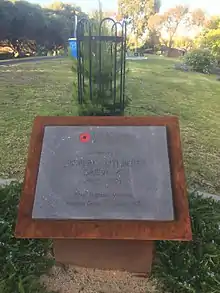Robert Grieve
Robert Cuthbert Grieve, VC (19 June 1889 – 4 October 1957) was an Australian recipient of the Victoria Cross, the highest award for gallantry "in the face of the enemy" that can be awarded to British and Commonwealth forces.
Robert Cuthbert Grieve | |
|---|---|
 Captain Robert Grieve c.1917 | |
| Born | 19 June 1889 Brighton, Victoria |
| Died | 4 October 1957 (aged 68) Melbourne, Victoria |
| Allegiance | Australia |
| Service/ | Australian Imperial Force |
| Years of service | 1915–18 |
| Rank | Captain |
| Unit | 37th Battalion |
| Battles/wars | First World War |
| Awards | Victoria Cross |
Early life
Born in Brighton, a suburb of Melbourne, to John and Annie Deas Grieve (née Brown), Grieve was educated at Caulfield Grammar School and then Wesley College. He became an interstate commercial traveller in the softgoods trade.
First World War
After nine months service in the Victorian Rangers, he enlisted in the Australian Imperial Force as a private on 9 June 1915. He was commissioned as a second lieutenant in the 37th Battalion in January 1916, was promoted to lieutenant in May 1916, and after training in England, was promoted to captain in France in February 1917.
In France he served at Armentières, Bois-Grenier, L'Epinette, Ploegsteert Wood, Messines, La Basse Ville, and Warneton.
He was awarded the Victoria Cross for his actions at Messines. The announcement and accompanying citation for the award was published in a supplement to the London Gazette of 31 July 1917, reading:[1]
On 7 June 1917 at Messines, Belgium, during an attack on the enemy's position, and after his own company had suffered very heavy casualties, Captain Grieve located two hostile machine-guns which were holding up his advance. Under continuous heavy fire from the two guns, he succeeded in bombing and killing the two gun crews, then reorganized the remnants of his own company and gained his original objective. Captain Grieve set a splendid example and when he finally fell, wounded, the position had been secured.
Severely wounded in the shoulder by a sniper's bullet, Grieve was evacuated to England, and on recovery returned to his unit in October. However, due to subsequently suffering acute trench nephritis and double pneumonia, he was invalided to Australia in May 1918. On 7 August, at Scots Church, Sydney, he married Sister May Isabel Bowman of the Australian Army Nursing Service who had nursed him during his illness.
Post-war

Post-war he held the rank of captain in the Militia. He established the business of Grieve, Gardner & Co., soft-goods warehousemen, in Flinders Lane, Melbourne, and was managing director until 4 October 1957 when he died of cardiac failure.
He was buried with military honours in Springvale cemetery. Grieve's medal was presented by his family to Wesley College in 1959, and has been lent to the Shrine of Remembrance, where it is on permanent display. Grieve was an active supporter of Wesley College for many years and contributed towards an annual scholarship.
A home room at Wesley College is named in his honour as well as a 'Grieve Way' a street in Wodonga, Victoria.
Family
A son, Robert Henderson "Bob" Grieve (30 November 1924 – 15 December 2006) was a noted artist[2][3] and president of the Victorian branch of the Victorian branch of the Contemporary Art Society from 1967 to 1987.
Relation to John Grieve
A number of references including the 1997 edition of The Register of the Victoria Cross list Sergeant Major John Grieve VC (Crimea, 1854) and Captain Robert Cuthbert Grieve (Belgium, 1917) as great uncle and great nephew.[4] This connection was suggested by an article in The Times on 29 May 1964. The article said John Grieve sent home £75 from the Crimea to Robert Grieve and that if Robert Grieve was his brother and also emigrated, then some relationship may be established between the Crimean VC and an Australian First World War VC, Robert Grieve. However, descendants of both Grieve families have been in contact with each other and have found that they are not great uncle and great nephew.[5]
References
- "No. 30215". The London Gazette (Supplement). 31 July 1917. p. 7905.
- "Family Notices". The Argus. Melbourne: National Library of Australia. 6 December 1924. p. 17. Retrieved 30 March 2015.
- "Robert Grieve". Design & Art Australia Online. Retrieved 30 March 2015.
- Nora Buzzell (compiler), The Register of the Victoria Cross, This England, 1997, ISBN 0-906324-27-0, hardback, 352 pages at page 350
- Anthony Staunton. ‘A South Australian treasure: The VC to Sergeant Major John Grieve’, Sabretache, the journal of the Military Historical Society of Australia, Vol XLVII No. 3 September 2006, pages 31 to 34.
External links
- Darryl McIntyre, 'Grieve, Robert Cuthbert (1889–1957)', Australian Dictionary of Biography, Volume 9, Melbourne University Press, 1983, pp 106–107.
- Robert Cuthbert GRIEVE, AIF Project, adfa.edu.au